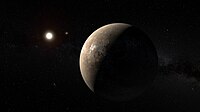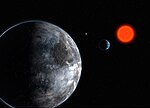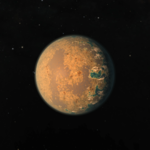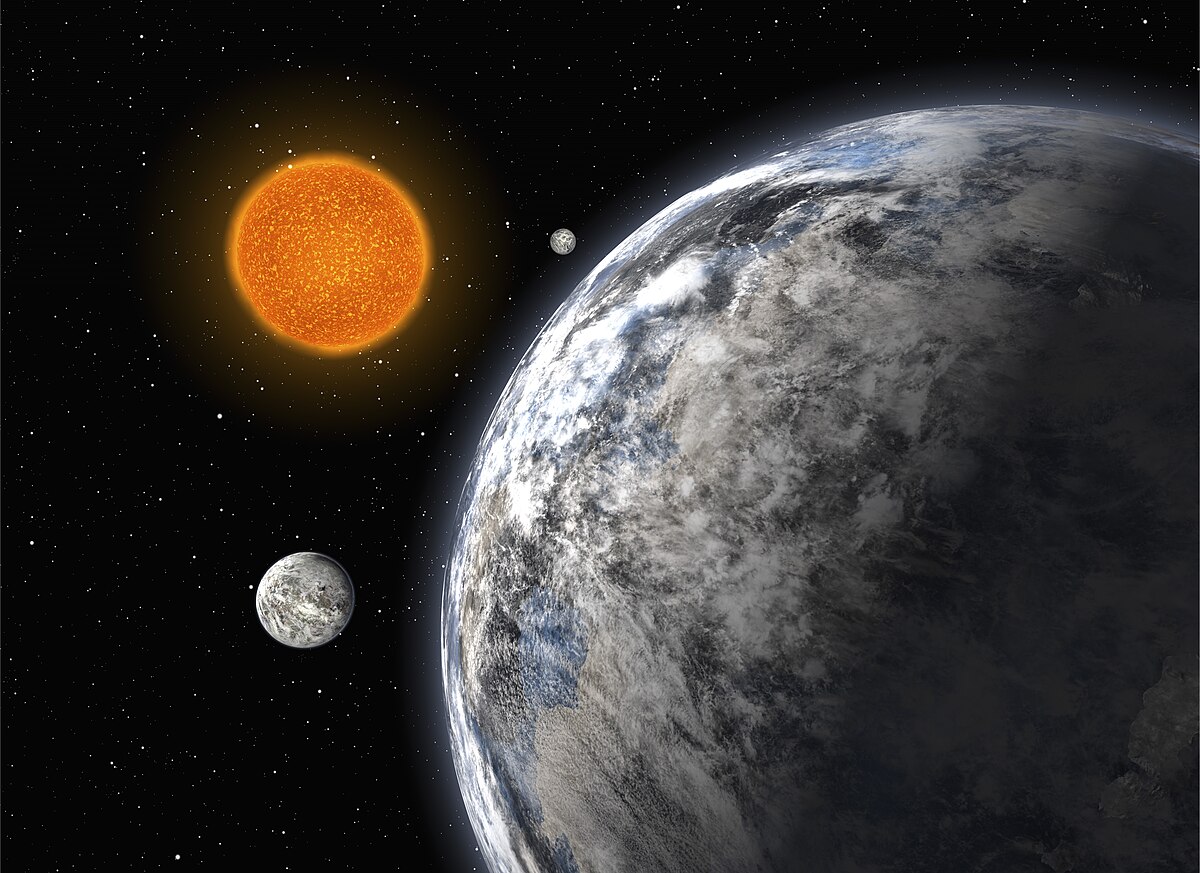「最寄りの地球型太陽系外惑星の一覧」の版間の差分
ページ「List of nearest terrestrial exoplanet candidates」の翻訳により作成 |
(相違点なし)
|
2018年9月26日 (水) 04:47時点における版
この最寄りの地球型太陽系外惑星の一覧は太陽系から最大50光年離れた地球型外惑星を距離順に並べたものである。[1][2][3]
これらの惑星は主にケイ酸塩岩および/また金属からなる。太陽系では地球型惑星は太陽に近い内側の惑星である。
発見されている外惑星(不完全)
この一覧は不完全である。現在33の外惑星が含まれているが、そのうち11は星のハビタブルゾーンの内部に位置している。
太陽系から50光年の距離までにおよそ2,000の星がある[4](そのうち64個は太陽のような黄色でオレンジ色の 「G星」である[5])。そのうち15%がハビタブルゾーンにあり地球規模の大きさを持っている。[6]
2013年11月4日、ケプラーの宇宙ミッションのデータに基づき、天の川銀河内の太陽のような星と赤色矮星のハビタブルゾーンで軌道に乗る地球規模の惑星が400億個もあることを報告した[7][8]。これらの推定惑星のうち110億個は太陽のような星を周回している可能性がある[9]。このような最寄りの惑星は12光年離れている可能性がある。
2016年8月24日、地球に最も近い星であるプロキシマ・ケンタウリのハビタブルゾーンで、岩石からなる惑星が発見されたことが発表された。プロキシマと呼ばれるこの惑星は、質量は地球の1.3倍であり、軌道周期は11.2地球日である[10]。しかしプロキシマ・ケンタウリの赤色矮星として分類は、低い恒星流、高い潮汐同期の可能性、小さい軌道惑星のハビタブルゾーン、高い恒星変動により軌道上の外惑星のハビタビリティに疑問を投げかけている。もう1つの有力候補は4.37光年離れた地球に最も近い太陽のような星系であるアルファケンタウリである。アルファケンタウリA,Bの周りに居住可能な惑星を見つけられる可能性を約85%に見積もっている[11]。アルファケンタウリはブレークスルー・スターショットやミッション・ケンタウルなどいくつかの外惑星発見ミッションのターゲットになっており、後者は2016年のドキュメンタリー映画"The Search for Earth Proxima"に記録されている。[12]
表
| 名 | イメージ | M⊕ | R⊕ | g | Ts | a | e | [s] | D |
|---|---|---|---|---|---|---|---|---|---|
| Proxima Centauri b |  |
≥1.27 | ~1.1 | 234 K -39°C |
0.05 | <0.35 | [13] | 4.22 | |
| Ross 128 b | ≥1.40 | 11.03 | |||||||
| Wolf 1061b | ≥1.36 | ≥1.44 | 13.8 | ||||||
| Wolf 1061c | ≥4.3 | ≥1.64 | [14] | 13.8 | |||||
| Wolf 1061d | ≥5.21 | ≥2.04 | 13.8 | ||||||
| Gliese 876 d[15] |  |
6.8 | Template:Bad[16] | 0.021 | 0.21 | [17] | 15 | ||
| Gliese 682 b | ≥2 | [18] |
16 | ||||||
| Gliese 832 c |  |
≥5.4 | 295 K 22 °C |
0.162 | 0.03 | [19] | 16.16 | ||
| 82 G. Eridani b | ≥2.7 | Template:Bad | 0.1207 | 0 | 19.71 | ||||
| 82 G. Eridani c | ≥2.4 | Template:Bad | 0.2036 | 0 | 19.71 | ||||
| 82 G. Eridani d | ≥4.8 | Template:Bad | 0.3499 | 0 | 19.71 | ||||
| Gliese 581 e |  |
≥1.7 | 0.029 | 0 | 20 | ||||
| Gliese 581 c [20] |  |
≥5.6 | 0.072 | 0 | [21] | 20 | |||
| Gliese 581 d [22] |  |
≥5.6 | 2.34[23] | 1.27 | 233 K -41 °C[23] |
0.218 | 0 | 20 | |
| HD 219134 b |  |
4.5 | 1.6 | Template:Bad | [24] | 21 | |||
| Gliese 667C b |  |
6.30 | 1.44 | Template:Bad | 0.05 | 0.09 | 22 | ||
| Gliese 667C c[25][26] |  |
3.8 | 1.32 | 302 K 29 °C |
0.13 | 0.34 | 22 | ||
| 61 Virginis b[27] |  |
≥5.1 | 0.050 | 0.12 | [28] | 28 | |||
| HD 85512 b[29] |  |
≥3.6 | 1.74 | 1.33 | 351 K 78 °C[23] |
0.26 | 0.11 | [30] | 36 |
| GJ 180 b | ≥2.3 | 312 K 39 °C |
[31] | 38 | |||||
| TRAPPIST-1b |  |
[32] | 39.5 | ||||||
| TRAPPIST-1c |  |
39.5 | |||||||
| TRAPPIST-1d |  |
282.1 K 9 °C[23] |
39.5 | ||||||
| TRAPPIST-1e |  |
246.1 K -27.1 °C[23] |
39.5 | ||||||
| TRAPPIST-1f |  |
219 K -54 °C[23] |
39.5 | ||||||
| TRAPPIST-1g |  |
198.6 K -75 °C[23] |
39.5 | ||||||
| TRAPPIST-1h |  |
169 K -104 °C[23] |
39.5 | ||||||
| 55 Cancri e (Janssen) |  |
8.6 | 0.016 | 0.17 | [33] | 40 | |||
| HD 40307 b[34] | ≥4.2 | 0.047 | 0.2 | 42 | |||||
| HD 40307 c | ≥6.8 | 0.081 | 0.06 | 42 | |||||
| HD 40307 d [35] |  |
≥9.2 | 0.134 | 0.07 | 42 | ||||
| HD 40307 e | ≥3.5 | 0.1886 | 0.15 | 42 | |||||
| HD 40307 f | ≥5.2 | Template:Bad | 0.247 | 0.02 | 42 | ||||
| HD 40307 g | ≥7.1 | 284 K 11 °C[36] |
0.600 | 0.29 | 42 |
注: 表のほとんどの惑星の陸上組成についての科学的コンセンサスはない。「メインソース」の情報源は、陸上組成の可能性を確証する。
2012年9月、グリーゼ163[37]の周りを周回する2つの惑星を発見したことが発表された[38][39]。その惑星の1つであるグリーゼ163cは、地球の質量の約6.9倍で、やや暑く、ハビタブルゾーン内にあると考えられていたが、おそらく地球型惑星ではない。2016年5月、極低温矮星TRAPPIST-1の3つの地球のような惑星の発見が発表された。
統計
| 距離 | ハビタブルゾーン内 | 全て |
|---|---|---|
| < 10光年 | 0 (2?) | 2系 |
| < 20光年 | 6 | 15 |
| < 30光年 | 8 | 22 |
| < 40光年 | 10 | 24 |
| < 50光年 | 11 | 31 |
注: ほとんどの場合、外惑星の大気組成と大気圧は不明なため、表面温度はコンピュータモデルと専門家の意見に基づいて推定される。
関連項目
脚注
- ^ Pepe, F. et al. (2011), “The HARPS search for Earth-like planets in the habitable zone: I – Very low-mass planets around HD20794, HD85512 and HD192310”, Astronomy & Astrophysics 534: A58, arXiv:1108.3447, Bibcode: 2011A&A...534A..58P, doi:10.1051/0004-6361/201117055
- ^ Schneider, Jean, “Star: HD 20794”, Extrasolar Planets Encyclopaedia (Paris Observatory) 2011年12月5日閲覧。
- ^ Tuomi, Anglada-Escude, Gerlach, Jones, Reiners, Rivera, Vogt, Butler, Mikko, Guillem, Enrico, Hugh R. R., Ansgar, Eugenio J., Steven S., R. Paul; Anglada-Escude, Guillem; Gerlach, Enrico; Jones, Hugh R. R.; Reiners, Ansgar; Rivera, Eugenio J.; Vogt, Steven S.; Paul Butler, R. (2012). “Habitable-zone super-Earth candidate in a six-planet system around the K2.5V star HD 40307”. Astronomy & Astrophysics 549: A48. arXiv:1211.1617v1. Bibcode: 2013A&A...549A..48T. doi:10.1051/0004-6361/201220268.CS1 maint: Multiple names: authors list (link)
- ^ “Stars within 50 light years”. 2015年10月3日閲覧。
- ^ “G stars within 100 light-years”. 2015年10月3日閲覧。
- ^ Tuomi, Mikko; Jones, Hugh R. A.; Barnes, John R.; Anglada-Escudé, Guillem; Jenkins, James S. (2014). “Bayesian search for low-mass planets around nearby M dwarfs. Estimates for occurrence rate based on global detectability statistics”. Monthly Notices of the Royal Astronomical Society 441 (2): 1545–1569. arXiv:1403.0430. Bibcode: 2014MNRAS.441.1545T. doi:10.1093/mnras/stu358.
- ^ Overbye, Dennis (2013年11月4日). “Far-Off Planets Like the Earth Dot the Galaxy”. New York Times 2013年11月5日閲覧。
- ^ Petigura, Eric A.; Howard, Andrew W.; Marcy, Geoffrey W. (October 31, 2013). “Prevalence of Earth-size planets orbiting Sun-like stars”. Proceedings of the National Academy of Sciences of the United States of America 110 (48): 19273–19278. arXiv:1311.6806. Bibcode: 2013PNAS..11019273P. doi:10.1073/pnas.1319909110. PMC 3845182. PMID 24191033 2013年11月5日閲覧。.
- ^ Khan, Amina (2013年11月4日). “Milky Way may host billions of Earth-size planets”. Los Angeles Times 2013年11月5日閲覧。
- ^ Anglada-Escudé, Guillem (August 24, 2016). “A terrestrial planet candidate in a temperate orbit around Proxima Centauri”. Nature 536 (7617): 437–40. arXiv:1609.03449. Bibcode: 2016Natur.536..437A. doi:10.1038/nature19106. PMID 27558064.
- ^ “Miniature Space Telescope Could Boost the Hunt for "Earth Proxima"”. Scientific American. Template:Cite webの呼び出しエラー:引数 accessdate は必須です。
- ^ “The Search for Earth Proxima”. The Atlantic. Template:Cite webの呼び出しエラー:引数 accessdate は必須です。
- ^ Anglada-Escudé, Guillem; Amado, Pedro J.; Barnes, John; Berdiñas, Zaira M.; Butler, R. Paul; Coleman, Gavin A. L.; de la Cueva, Ignacio; Dreizler, Stefan et al. (25 August 2016). “A terrestrial planet candidate in a temperate orbit around Proxima Centauri” (英語). Nature 536 (7617): 437–440. arXiv:1609.03449. Bibcode: 2016Natur.536..437A. doi:10.1038/nature19106. ISSN 0028-0836. PMID 27558064.
- ^ http://phl.upr.edu/projects/habitable-exoplanets-catalog/data
- ^ Fogg, M. J.; Nelson, R. P. (2005). “Oligarchic and giant impact growth of terrestrial planets in the presence of gas giant planet migration”. Astronomy and Astrophysics 441 (2): 791–806. arXiv:astro-ph/0507180. Bibcode: 2005A&A...441..791F. doi:10.1051/0004-6361:20053453.
- ^ Rivera, E. et al. (2005). “A ~7.5 M⊕ Planet Orbiting the Nearby Star, GJ 876”. The Astrophysical Journal 634 (1): 625–640. arXiv:astro-ph/0510508. Bibcode: 2005ApJ...634..625R. doi:10.1086/491669.
- ^ Eugenio J. Rivera, Gregory Laughlin, R. Paul Butler, Steven S. Vogt, Nader Haghighipour, Stefano Meschiari (2010). "The Lick-Carnegie Exoplanet Survey: A Uranus-mass Fourth Planet for GJ 876 in an Extrasolar Laplace Configuration".
- ^ http://www.hpcf.upr.edu/~abel/phl/tuomi/hec_orbit_GJ_682_b.png
- ^ “A Nearby Super-Earth with the Right Temperature but Extreme Seasons - Planetary Habitability Laboratory @ UPR Arecibo”. 2015年10月3日閲覧。
- ^ Valencia; Sasselov, Dimitar D.; O'Connell, Richard J. (2006). “Radius and Structure Models of the First Super-Earth Planet”. The Astrophysical Journal 656 (1): 545–551. arXiv:astro-ph/0610122. Bibcode: 2007ApJ...656..545V. doi:10.1086/509800.
- ^ Vogt, S. S. (2010). “The Lick-Carnegie Exoplanet Survey: A 3.1 M_Earth Planet in the Habitable Zone of the Nearby M3V Star Gliese 581”. The Astrophysical Journal 723: 954–965. arXiv:1009.5733. Bibcode: 2010ApJ...723..954V. doi:10.1088/0004-637x/723/1/954.
- ^ von Bloh, W.; Bounama, C.; Cuntz, M.; Franck, S. (2007). “The Habitability of Super-Earths in Gliese 581”. Astronomy & Astrophysics 476 (3): 1365–1371. arXiv:0705.3758. Bibcode: 2007A&A...476.1365V. doi:10.1051/0004-6361:20077939.
- ^ a b c d e f g h The Habitable Exoplanets Catalog. The values are just the best estimates and are subject to change.
- ^ http://phys.org/news/2015-07-astronomers-star-super-earths.html
- ^ Bonfils; Delfosse; Udry; Forveille; Mayor; Perrier; Bouchy; Gillon et al. (2011). “The HARPS search for southern extra-solar planets XXXI. The M-dwarf sample”. Astronomy 549: A109. arXiv:1111.5019. Bibcode: 2013A&A...549A.109B. doi:10.1051/0004-6361/201014704.
- ^ “A Potential Habitable Exoplanet in a Nearby Triple Star System - Planetary Habitability Laboratory @ UPR Arecibo”. 2015年10月3日閲覧。
- ^ Vogt, Steven; Wittenmyer; Paul Butler; Simon O'Toole; Henry; Rivera; Stefano Meschiari; Gregory Laughlin et al. (2009). “A Super-Earth and two Neptunes Orbiting the Nearby Sun-like star 61 Virginis”. The Astrophysical Journal 708: 1366–1375. arXiv:0912.2599v1. Bibcode: 2010ApJ...708.1366V. doi:10.1088/0004-637X/708/2/1366.
- ^ Vogt, Steven (2009). \"A Super-Earth and two Neptunes Orbiting the Nearby Sun-like star 61 Virginis
- ^ Kaltenegger, L; Udry, S; Pepe, F (2011). A Habitable Planet around HD 85512?. 1108. pp. 3561. arXiv:1108.3561. Bibcode: 2011arXiv1108.3561K.
- ^ Kaltenegger, L.; Udry, S.; Pepe, F. (2011). A Habitable Planet around HD 85512?
- ^ “HEC: Data of Potentially Habitable Worlds - Planetary Habitability Laboratory @ UPR Arecibo”. 2015年10月3日閲覧。
- ^ Gillon, M; Triaud, AH; Demory, BO; Jehin, E; Agol, E; Deck, KM; Lederer, SM; de Wit, J et al.. “Seven temperate terrestrial planets around the nearby ultracool dwarf star TRAPPIST-1” (PDF). Nature 542: 456–460. arXiv:1703.01424. Bibcode: 2017Natur.542..456G. doi:10.1038/nature21360. PMC 5330437. PMID 28230125.
- ^ Rebekah; et al (2010). “Radial velocity planets de-aliased. A new, short period for Super-Earth 55 Cnc e”. The Astrophysical Journal 722: 937–953. arXiv:1005.4050. Bibcode: 2010ApJ...722..937D. doi:10.1088/0004-637x/722/1/937.
- ^ M. Mayor; S. Udry; C. Lovis; F. Pepe; D. Queloz; W. Benz; J.-L. Bertaux; F. Bouchy et al. (2009). “The HARPS search for southern extra-solar planets. XIII. A planetary system with 3 Super-Earths (4.2, 6.9, & 9.2 Earth masses)”. Astronomy and Astrophysics 493 (2): 639–644. arXiv:0806.4587. Bibcode: 2009A&A...493..639M. doi:10.1051/0004-6361:200810451.
- ^ Barnes, R., Jackson, B., Raymond, S., West, A., Greenberg, R. (2009). “The HD 40307 Planetary System: Super-Earths or Mini-Neptunes?”. The Astrophysical Journal 695 (2): 1006–1011. arXiv:0901.1698. Bibcode: 2009ApJ...695.1006B. doi:10.1088/0004-637X/695/2/1006.
- ^ “HEC: Data of Potential Habitable Worlds”. University of Puerto Rico at Arecibo (Planetary Habitability Laboratory) (2012年11月12日). Template:Cite webの呼び出しエラー:引数 accessdate は必須です。
- ^ Staff (2012年9月20日). “LHS 188 -- High proper-motion Star”. Centre de données astronomiques de Strasbourg(Strasbourg astronomical Data Center). 2012年9月20日閲覧。
- ^ Méndez, Abel (2012年8月29日). “A Hot Potential Habitable Exoplanet around Gliese 163”. University of Puerto Rico at Arecibo (Planetary Habitability Laboratory). 2012年9月20日閲覧。
- ^ Redd, Nola Taylor (2012年9月20日). “Newfound Alien Planet a Top Contender to Host Life”. Space.com. 2012年9月20日閲覧。

